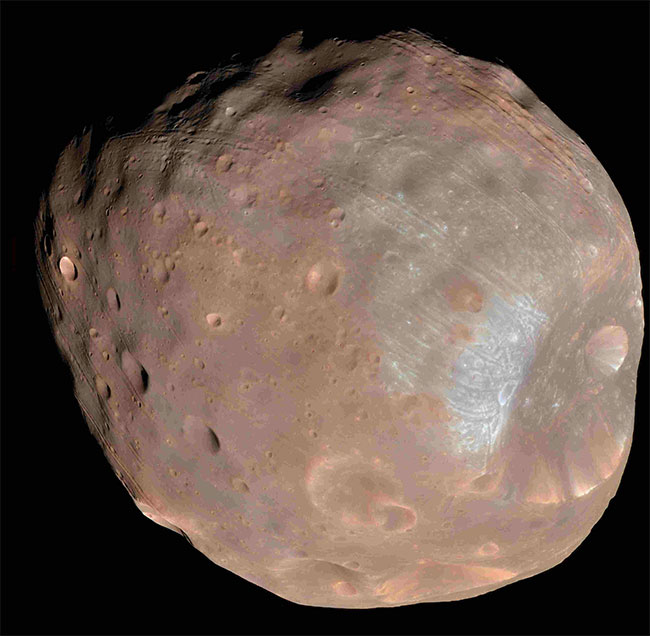Phobos satellite origin of Mars
Astronomers have long argued about the origin of Mars satellites. There are two most popular theories.
According to the first theory, two satellites Phobos and Deimos may be asteroids captured by Mars.
Meanwhile, the second theory said that these two satellites formed from matter that flew out during the process of Mars colliding with some large object . The latest study by scientists at Stony Brook University (USA) shows that the second theory seems more reasonable, especially for the Phobos satellite case. Interestingly, this study is based on a new analysis of data collected from . 20 years ago.

Phobos satellite.
The shape and color of the two satellites Phobos and Deimos show that they may be captured by Mars-mass asteroids as they fly near the planet. However, this explanation is not correct, as scientists analyze the shape and tilt of the orbits of two satellites. The analysis showed that two satellites could form from matter that was thrown out during the process of Mars colliding with some large object. The new analysis of data collected by Mars Global Surveyor 20 years ago proves that the material that makes Phobos is very similar to material from the mantle of Mars. This shows that the second theory seems more reasonable.
Experts in planetary astronomy admit that while we discover a lot, without a clear explanation of the origin of Mars satellites, that is not the reason to be proud. The problem is that the results of the spectral analysis of chemical components of Phobos and Deimos contradict the results of dynamic analysis of their orbit. Only when analyzing new data collected 20 years ago, scientists have found that these satellites may have formed from Martian matter.
In visible light, Phobos and Deimos seem much darker than Mars. Spectroscopic studies based on the analysis of reflected light from these satellites show that Phobos's material is very similar to the Class D miniaturized material - rich in carbon and less reflective. An international team of astronomers, led by Timothy D. Glotch at Stony Brook University, decided to re-analyze heat indicators collected by the Mars Global Surveyer, when it flew over Phobos. . The results were compared with the results of the spectral analysis of Class D asteroid fragments, found in the Tagish Lake area (Canada).
'It turns out, the spectrum of the Tagish Lake meteorite is completely unlike the Phobos spectrum,' said Glotch. Phobos. That led us to lean on the theory that Phobos is indeed the remainder after a cosmic collision in the fledgling Mars history. ' The new study also says that Phobos not only has material from Mars but also matter from celestial bodies that have collided with Mars .
- Russia is about to take land on Mars's satellite
- China plans to conquer Mars
- What happens if the Russian spacecraft falls to earth?
- Mars can form belts from the moons
- Mars Express prepares to approach the moon Mars
- Russia is preparing to launch the second Phobos-Grunt
- Russia will launch ships on Mars's satellites
- The broken moon will turn the belt around Mars
- Mars's largest moon 'crushed' a city
- Russia began exploring Mars's satellites
- Russia will launch ships to collect specimens from the moon Mars
- Phobos-Grunt station may be affected by US radar
 Van Allen's belt and evidence that the Apollo 11 mission to the Moon was myth
Van Allen's belt and evidence that the Apollo 11 mission to the Moon was myth The levels of civilization in the universe (Kardashev scale)
The levels of civilization in the universe (Kardashev scale) Today Mars, the sun and the Earth are aligned
Today Mars, the sun and the Earth are aligned The Amazon owner announced a secret plan to build a space base for thousands of people
The Amazon owner announced a secret plan to build a space base for thousands of people